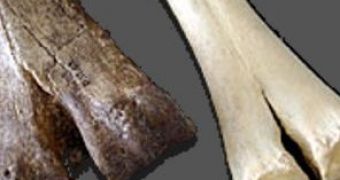The bones of an ancient giant camel that lived 100,000 years ago have been discovered by a team of Swiss and Syrian archaeologists deep within the Palmyra desert in Syria.
The first large bones were unearthed three years ago in the El Kowm area, 250km (155 miles) north of Damascus, but only recent remains found this summer confirmed the identity of the animal. "We found the first traces of a big animal in 2003, but we were not sure if it was a giant camel," Jean-Marie Le Tensorer, a pre-history professor at the University of Basel, said. "This is a big discovery, a revolution in science."
The ancient animal would have been three to four meters tall, twice the size of modern camels, "as big as a giraffe or an elephant", and was apparently hunted by humans as it watered from a spring.
The finding proves that camel species existed in the area 90,000 years earlier than previously thought. "It was not known that the dromedary was present in the Middle East more than 10,000 years ago," said Le Tensorer.
Camel remains were encountered in various layers of rock, so the species suggesting had existed in the region for thousands of years. Nearby human remains were discovered including tools made from animal foot bones that dated from the same period, but scientists did not decode if they belong to the modern man or Neanderthal. "This find is sensational as it could help us understand the evolution of the camel," said Peter Schmid, an anthropologist from the University of Zurich.
Basam Jamous, head of the country's Department of Antiquities, told "This discovery shows that the Syrian desert is where the camel, the so-called 'ship of the desert' first emerged on earth. "Evidence of human habitation in Syria dates as far back as 1.5 million years and the El Kowm region, a 14-mile plain nestled between two mountain ranges, is a particularly rich area for Paleolithic finds."
The abundance of human and animal populations of this area during Paleolithic was showed by findings in more than 180 sites, some 750,000 years old. During Pleisthocen this area had abundant water sources, being a savannah grassland like those in Eastern Africa, and not an arid sandy desert as it is today.

 14 DAY TRIAL //
14 DAY TRIAL //